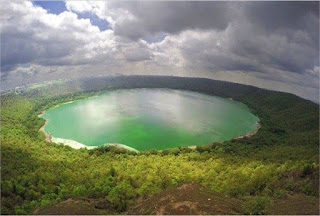Lonar Lake, also known as Lonar crater, is a notified National Geo-heritage Monument, saline, soda lake, located at Lonar in Buldhana district, Maharashtra, India. Lonar Lake was created by an asteroid collision with earth impact during the Pleistocene Epoch.
It is one of the four known, hyper-velocity, impact craters in basaltic rock anywhere on Earth. The other three basaltic impact structures are in southern Brazil. Lonar Lake has a mean diameter of 1.2 kilometres (3,900 ft) and is about 137 metres (449 ft) below the crater rim. The meteor crater rim is about 1.8 kilometres (5,900 ft) in diameter.
Lonar Crater sits inside the Deccan Plateau – a massive plain of volcanic basalt rock created by eruptions some 65 million years ago. Its location in this basalt field suggested to some geologists that it was a volcanic crater. Today, however, Lonar Crater is understood to be the result of a meteorite impact that occurred between 35,000 and 50,000 years ago. The water in the lake is both saline and line .
The crater's age is usually estimated to be 52,000 ±6,000 years, although a study published in 2010 suggests an age of 570,000 ± 47,000 years.
The Smithsonian Institution, the United States Geological Survey, Geological Survey of India,the University of Sagar and the Physical Research Laboratory have conducted extensive studies of the site. Biological nitrogen fixation was discovered in this lake in 2007.
A 2019 study, conducted by IIT Bombay found that the minerals, in the lake soil, are very similar to the minerals found in moon rocks brought back during the Apollo Program.





Wow😍
ReplyDeletePost a Comment